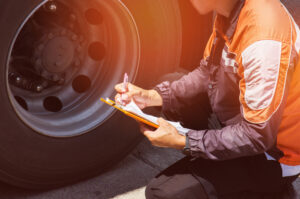Why is a Class A CDL Pre-Trip Inspection Needed?
Generally, it is required by law to perform a pre-trip truck inspection at least every 24-hour driving period. The truck pre-trip inspection test should start any truck driver’s day. A good pre-trip inspection Class A should take at least half an hour to complete. Being thorough will help ensure you do not miss any needed repairs or law violations. The most common reason for a truck to fail a roadside safety inspection is because “common sense” steps were missed.

Pre-Trip Inspection Checklist
In general, most inspections require the same points to be inspected. However, some companies may have additions to their inspection requirements. The following list of the most common items that should be inspected daily.
- Medical cards – keep this on you always and check the expiration date.
- Leaks – check the engine block, all hoses and connections, and beneath the truck for leaks. Note any leaks present, then make sure the necessary repairs are completed.
- Fluid levels – ensuring all fluids are at recommended levels will prevent any surprise damages. Check the function of the oil pressure gauge and all caps and dipstick. These should not be cracked or loose.
- Belts – within the engine compartment. All belts should be checked to ensure they are not loose, frayed, or too dry.
- Steering – regardless of whether the steering has power or not, there should not be any play in the steering wheel. This could cause the driver to lose control. Also, test the horn at this time.
- Transmission – the clutch and gear shift should move smoothly and into all gears.
- Brakes both the parking brake and emergency brakes for the truck and trailer should be in full working order. Any malfunction, breaks, or leaks can cause an accident, which can be fatal to all involved.
- Mirrors and windshields – should be checked for damage, obstruction keeping them from proper placement, and cleanliness.
- Air lines – any leaks or broken lines need to be fixed immediately. While checking these, the fifth wheel, if attached already, should be coupled tightly without play.
- Lights and reflectors – all lights should be in working order, including the emergency lights. Reflectors and reflective strips were checked for dried, broken, or missing pieces.
- Tires, wheels, and rims – each tire should be checked for proper air pressure, tread, and any wires showing or dry rot beginning to appear. Check the rims for flat spots or damage. The wheels need to be inspected for any rust, especially around the lug nuts; this can cause larger holes, preventing them from fitting properly. If rims/wheels have been painted, ensure rust has not been covered up. While you are checking your tires, look at the brakes and make sure they have the proper depth.
- Emergency equipment – this is especially important if you are not the only driver for this truck. All trucks are required to have safety equipment on board. This includes but is not limited to, spare electrical fuses in good shape, reflective triangles, and a properly charged and rated fire extinguisher.
After the inspection is complete and all problems have been noted and repaired, then complete the paperwork required for the logbooks.
Consequences of an Incomplete Inspection
Pre-trip inspection rules are set by the Federal Motor Carrier Safety Administration (FMCSA). If an inspection is not completed or steps have been overlooked, this can result in the driver receiving Compliance, Safety, and Accountability (CSA) violations, as well as legal violations. The numbers received from these violations go on the driver’s record. This can result in being flagged for a visit by the Department of Transportation (DOT). Another consequence is preventable damage to the engine or vehicle. Being involved in an accident can also occur from important repairs being missed.
However, pre-trip inspections are just as important for the truck as a good, healthy meal is to a driver. Skipping steps to hurry the process of falsifying reports hurts the driver’s record and risks potential truck issues/failure and the possibility of losing work.


